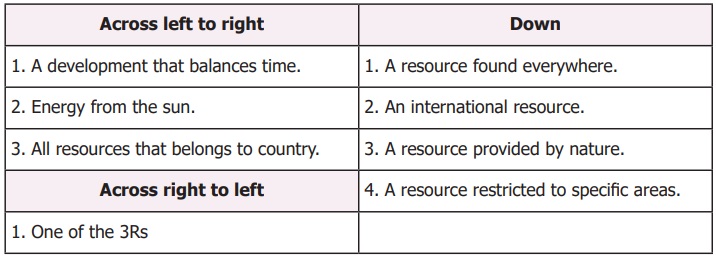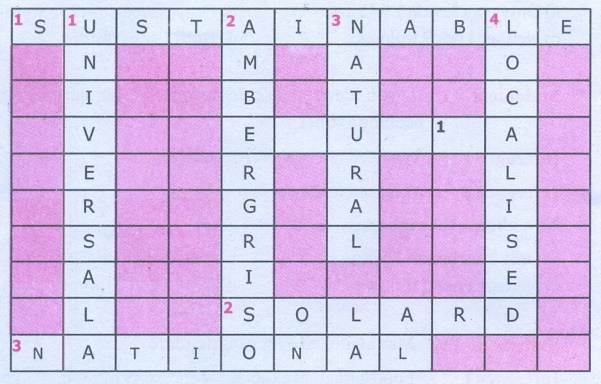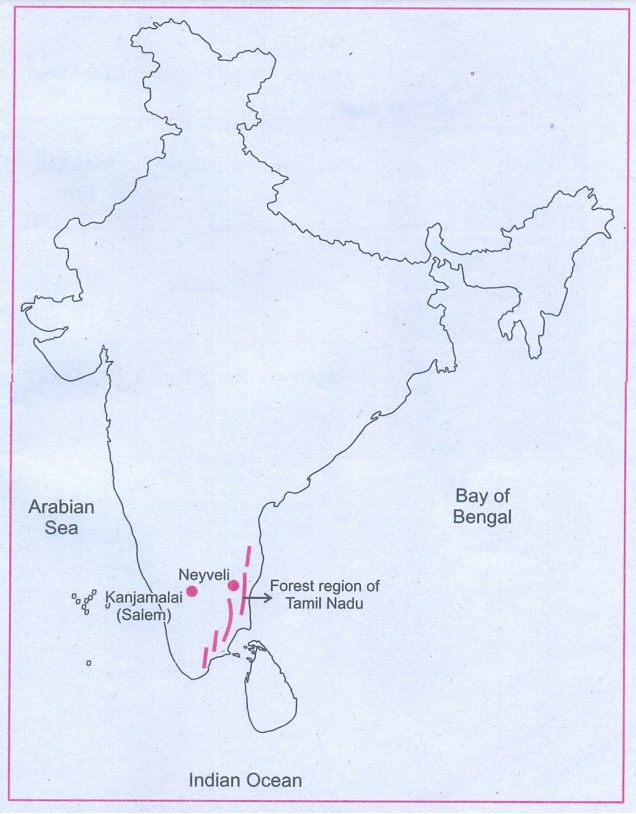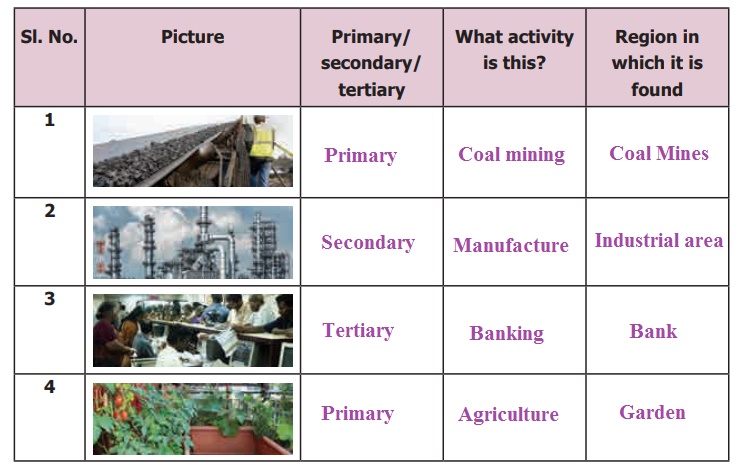Resources | Term 2 Unit 1 | Geography | 6th Social Science - Exercises Questions with Answers | 6th Social Science : Geography : Term 2 Unit 1 : Resources
Chapter: 6th Social Science : Geography : Term 2 Unit 1 : Resources
Exercises Questions with Answers
Exercises
A. Match the following.
A / B
Natural resource- Minerals
International resource-Sustainable development
Reduce, Reuse, Recycle-Air
Non-renewable-Manufacturing
Universal resource-Ambergris
Secondary activities-Forest
Answer:
Natural resource - Air
International resource - Ambergris
Reduce, Reuse, Recycle - Sustainable development
Non-renewable - Minerals
Universal resource - Forest
Secondary activities - Manufacturing
B) Fill in the blanks.
1. Sugarcane is processed to make sugar.
2. Conservation of resources is careful use of resources.
3. Resources which are confined to certain regions are called localized resources.
4. Actual resources are being used in the present.
5. Natural resources are the most valuable resources.
6. Collection of resources directly from nature is called primary activity.
C) Write short notes on the following.
1. Renewable resources.
Resources once consumed can be renewed with the passage of time are called renewable resources. (e.g.) Air, Water, Sunlight.
2. Human resources.
Human resources are groups of individuals who use nature to create more resources. Though human beings are basically natural resources, we classify human beings separately. Education, health, knowledge and skill have made them a valuable resource. (e.g.) Doctors, Teachers, Scientists.
3. Individual resources.
Individual resources are resources privately owned by individuals. (e.g.) Apartments.
4. Tertiary activities
Tertiary activities are those which render services to production and distribution of goods.
D) Give brief answers for the following.
1. What are resources?
Resource is anything that fulfills human needs. When anything is of some use it becomes valuable. All resources have value.
2. What are actual resources?
Actual resources are resources that are being used and the quantity available is known, (e.g.) Coal at Neyveli.
3. Define abiotic resources.
Abiotic resources are non-living things. Land, water, air and minerals are abiotic resources.
4. What is sustainable development?
If the present needs of resources are met and the conserving of resources for the future are balanced, we call it sustainable development.
E. Give short answers for the following questions.
1. Differentiate universal and localized resources.
On the basis of distribution, resources can be classified into localized resources and universal resources.
i. When resources are present in specific regions they are called localized resources. (e.g.) Minerals.
ii. Some resources are present everywhere. Such resources are called universal resources. (e.g.) Sunlight and air.
2. Though human beings are natural resources, why are they classified separately?
Though human beings are basically natural resources, we classify human beings separately. Education, health, knowledge and skill have made them a valuable resource. (e.g.) Doctors, Teachers, Scientists.
3. Compare national and international resources.
National resources are resources within the political boundaries and oceanic area of a country.(e.g.) Tropical forest regions of India.
International resources are all oceanic resources found in the open ocean. Resources found in this region can be utilized only after an international agreement. (e.g.) Ambergris.
4. What is the difference between man-made resources and human resources?
Man-made Resources: Natural resources are modified or processed by technology into man-made resources. (e.g.) sugarcane is processed to get sugar. All structures built by man can also be called man-made resources. (e.g.) Bridges, Houses, Roads.
Human Resource: Human resources are groups of individuals who use nature to create more resources. Though human beings are basically natural resources, we classify human beings separately. Education, health, knowledge and skill have made them a valuable resource. (e.g.) Doctors, Teachers, Scientists.
5. Write the Gandhian thought on conservation of resources.
There is enough for everybody's need and not for anybody's greed. Mahatma Gandhi blamed "human beings" for depletion of resources because of
(i) Over exploitation of resources
(ii) Unlimited needs of human beings. So, conservation is very important.
F. Give detailed answers for the following questions. (100-120 words)
1. How are natural resources classified? Explain any three with examples.
Natural resources can be classified into different groups depending on origin, development, renewability, distribution, ownership etc.
A. On the basis of origin : On the basis of origin, resources can be classified into biotic and abiotic resources.
i. All living resources are biotic resources. Plants, animals and other micro organisms are biotic resources.
ii. Abiotic resources are non-living things. Land, water, air and minerals are abiotic resources.
B. On the basis of Development: Based on the level of development, resources can be divided into actual and potential resources.
i. Actual resources are resources that are being used and the quantity available is known. (e.g.) Coal at Neyveli.
ii. Potential resources are resources that are not being used in the present and its quantity and location are not known. The technology to extract such resources is also yet to be developed. (e.g.) Marine yeast found in the Bay of Bengal and Arabian Sea.
C. On the basis of Exhaustibility : On the basis of renewability resources can be classified as renewable resources and non-renewable resources.
i. Resources once consumed can be renewed with the passage of time are called renewable resources. (e.g.) air, water, sunlight. Misuse of such resources can also limit its available quantity. So, they have to be used wisely.
ii. Natural resources which are limited can be called non-renewable resources. They become exhausted after use and the time they take to replace does not match the life cycle. (e.g.) Coal, petroleum, natural gas and other minerals.
2. How can resources be conserved?
Conservation of Resources: Careful use of resources is called conservation of resources. Resources are being used at a very fast rate due to the rapid increase in population. So, natural resources are depleting fast; wisely using resources can control the depleting ratios.
Development is necessary without affecting the needs of the future generations. If the present needs of resources are met and the conserving of resources for the future are balanced, we call it sustainable development. Sustainable development can take place when
(i) The reasons of depletion are identified.
(ii) Wastage and excess consumption is prevented.
(iii) Reusable resources are recycled.
(iv) Pollution is prevented.
(v) Environment is protected.
(vi) Natural vegetation and wild life are preserved.
(vii) Alternative resources are used.
The easiest way to conserve resources is to follow the '3R's: Reduce, Reuse and Recycle.
3. What is resource planning and why is it necessary?
Resource planning / Management: Resource planning is a technique or skill of proper utilization of resources. Resource planning is necessary because
(i) Resources are limited. Their planning is quite necessary so that we can use them properly and at the same time we can save them for our future generation.
(ii) Resources are not only limited but also they are unevenly distributed over the different parts of the world.
(iii) It is essential for the production of resource to protect them from over-exploitation.
4. Explain the primary, secondary and tertiary activities.
In the beginning, man had only three basic needs-food, clothing and shelter. He collected things through primary activities such as hunting, food gathering, fishing and forestry. Later when food became scarce, they had to cultivate and that became agriculture and the cattle were also reared on their farms to fulfil their basic needs.
Conversion of natural goods come under secondary activity. Manufacturing, construction, small and large scale industries are examples for this activity.
Tertiary activity includes services. Transport, insurance, banking and trade come under tertiary activity.
G) Statements and inferences.
1. Statement: Solar energy is the best substitute for thermal energy in tropical regions.
Inference 1: Coal and petroleum resources are receding.
Inference 2: Solar energy will never deplete.
Now choose the right answer.
a) Only conclusion 1 follows.
b) Only conclusion 2 follows.
c) Neither 1 nor 2 follows.
d) Both 1 and 2 follow.
Answer: d) Both 1 and 2 follow.
2. Statement: If you don’t conserve resources, human race may become extinct.
Inference 1: You need not conserve resources.
Inference 2: You need to conserve resources.
Now choose the right answer.
a) Only conclusion 1 follows.
b) Only conclusion 2 follows.
c) Neither 1 nor 2 follows.
d) Both 1 and 2 follow.
Answer: b) Only conclusion 2 follows.
3. Statement: Man switched over to agriculture.
Inference 1 : Food gatherers experienced scarcity of food.
Inference 2: Food gathered was not nutritious.
Now choose the right answer.
a) Only conclusion 1 follows.
b) Only conclusion 2 follows.
c) Neither 1 nor 2 follows.
d) Both 1 and 2 follow.
Answer: a) Only conclusion 1 follows.
H Given are three suggestions to conserve resources: Write the 3Rs in suitable places
1. Giving your childhood cycle to your neighbour Recycle.
2. Using a flush that consumes less water Reduce.
3. Melting used plastic to lay roads Reuse.
I. Cross word puzzle.


Across left to right
1. A development that balances time. - SUSTAINABLE
2. Energy from the sun. - SOLAR
3. All resources that belongs to country. - NATURAL
Across right to left
1. One of the 3Rs - REUSE
Down
1. A resource found everywhere. - UNIVERSAL
2. An international resource. - AMBERGRIS
3. A resource provided by nature. - NATURAL
4. A resource restricted to specific areas. - LOCALISED

J. Mark the following in the outline map of India.
1. Neyveli
2. Bay of Bengal
3. Arabian Sea
4. Forest region of Tamil Nadu
5. Indian Ocean
6. Iron mining in Kanjamalai (Salem)

K. Identify the different economic activities and fill the table given below.

L. Teacher’s Activities:
1. Observe “Save Energy Day” once in a month at school / class level.
2. Try making wall hangings with waste materials to decorate your school corridors.
3. Find out if there are any industries nearby your school. A field trip may be arranged.
4. Collect pictures based on
a.Fishing
b.Hunting
c. Food-gathering
d.Forestry
e.Mining
f.Agriculture
g.Cattle-rearing
h.Lumbering
Related Topics